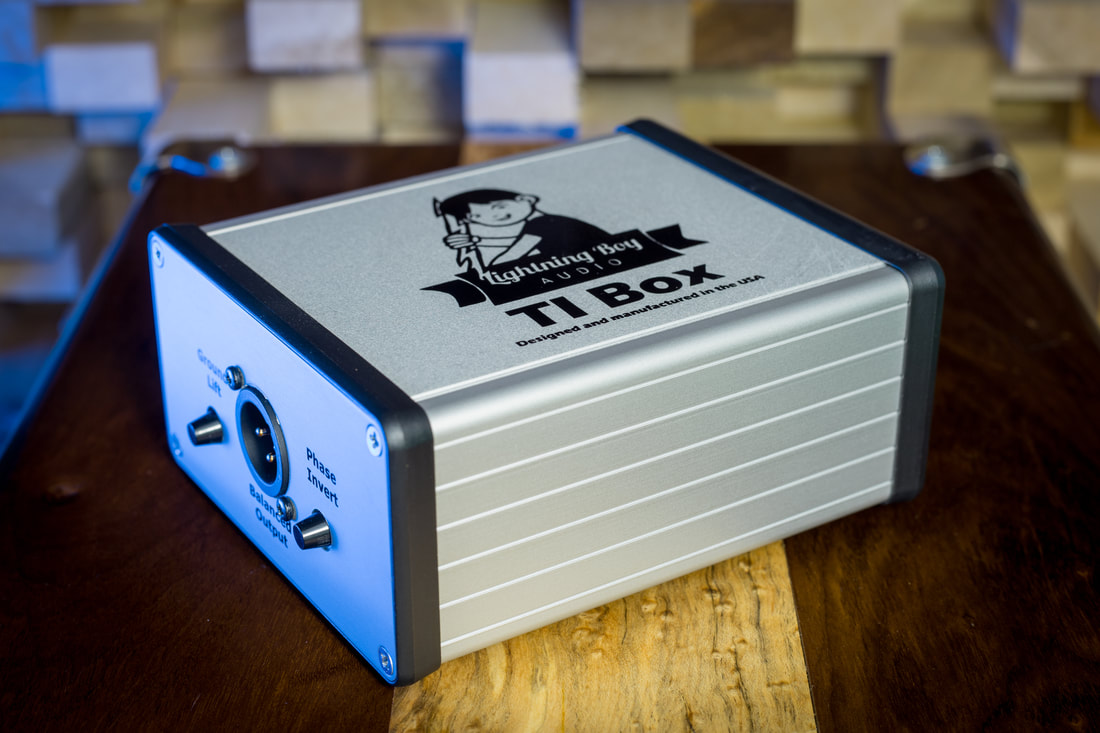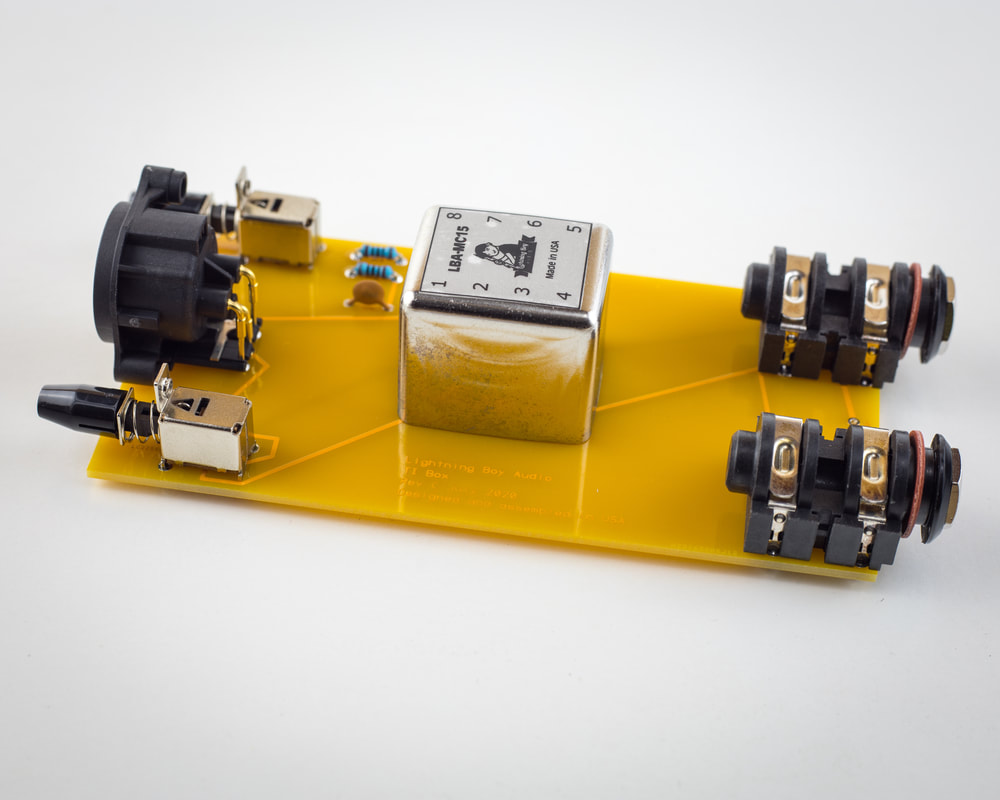New Gear Review: Thicker Injection Box by Lightning Boy Audio

The Thicker Injection Box by Lightning Boy Audio is a DI Box with some welcome vintage flavor—is it the right choice for your studio?
In a perfect world, we’d have the time and patience to try out all of the innumerable studio tools available to us. Though it’s common to fantasize about the perfect setup, it’s more practical to prioritize our equipment purchases based on actual needs, not gear lust. It may be a fair assumption to say that items like mics, preamps, equalizers, compressors, effects, and audio interfaces probably sit atop the list for most.
One piece of gear that you might not think about too often—despite how useful it can be—is the lowly direct box. Maybe you have a particular brand you default to trusting. Maybe you just use whatever’s nearby. A few recording studios I’ve worked in seem to have an endless supply in a back closet. “Would you prefer active or passive?” Just bring ‘em all in and set ‘em right there.
Nowadays, the vast majority of bedroom producers likely don’t own a standalone direct box because it’s so easy (and cost-effective) to plug directly into a recording interface’s Hi-Z input instead. So, in my view, if you’re going to construct a direct box, you need to provide the user with something distinct but still painless to use.
In my quest to find a unique take on an essential tool, I stumbled upon the newly released Thicker Injection Box by Lightning Boy Audio. Located in a rural village of upstate New York, the company designs and manufactures vacuum tube-based recording equipment and audio transformers. It’s led solely by Mike Congilosi II who years ago discovered an untapped passion for transformer theory and design with a little help from his late Uncle Joe.
Let’s see if there’s any extra mojo the Thicker Injection Box, aka TI Box, can offer musicians and audio creatives.
Features
Since 2011, Congilosi has been creating studio equipment for friends and customers, while also working with artists and bands in his studio, which houses a lot of exclusive handmade equipment. The Thicker Injection Box isn’t too dissimilar from gear that Congilosi has produced before. In fact, the initial design came from a theory he had two years ago when imagining a passive direct box with vintage flair.
First and foremost, the direct box centers around a custom-designed LBA-MC15 transformer. Lightning Boy Audio’s signature logo is adorned on top of the silver-colored chassis, and the bottom has four rubber feet already attached to it. On the one side of the box, 1/4″ input and bypass jacks are positioned and labeled side-by-side with slightly different colored washers, helping to further distinguish the connectors. The opposite side is where you’ll find a Neutrik XLR balanced output jack, phase invert switch, and ground lift switch. Congilosi states that “this is technically not a lift, but rather a ground loop hum rejection filter.”
In Use
When I received the TI Box in the mail, I was pleasantly surprised by the packaging. The unit was wrapped in orange tissue paper inside a yellow box. Sitting atop the TI Box was a 1-year warranty card with the unit’s serial number signed by Congilosi. I always appreciate personal touches like this from smaller companies. Taking it out of the wrapping, I quickly noticed how lightweight the direct box felt in my hand. I immediately picked up my Radial ProDI in the opposite hand to compare the two. The TI Box was clearly less dense.
Before testing it against the ProDI, I was really interested in doing a shootout between the TI Box and my Universal Audio Apollo 8’s Hi-Z input. Again, it is so effortless to plug straight into an audio interface these days. I wondered what subtleties I might be able to hear and measure between the units. Right off the bat, I found the TI Box to have less mid-range bite, which was more pleasing to my ear. Personally, I’d rather the mids not be accentuated any more than necessary, especially when recording certain electric guitars, such as a Strat.
These days, I typically use one or more of the following when recording guitar and bass: Radial ProDI, A Designs REDDI, API 512c, or Burl B1D. I’m not sure how fair it would be to put the TI Box up against the latter two, but I was curious to hear how it might stack up against the ProDI and REDDI.
Now, as many know, the REDDI is an active tube DI with a much heftier price tag. Still, the differences between these pieces of gear were intriguing. I tried my best to A/B test without being too influenced by years of using the REDDI, but I was able to accurately hone in on the textural differences. I found myself drawn to the REDDI for its warmth and a fuller sound in the lows, especially when playing bass. With that said, similar to the REDDI, the TI Box was taking the edge off the high end, which was a nice touch that gives it a faintly older sonic stamp.
When it came to the ProDI, it was immediately noticeable how much more comparable it was to the TI Box. What I really enjoyed about the TI Box, in this case, were the subdued highs again, but also the additional bump in the low mids (550Hz and 900Hz). Congilosi states on his site that “You’ll probably notice a bit of heft in the sub-bass, dominance in the mids, and a slight softening in the highs, all of which define the TI Box sound.” I would say that’s a pretty fair assessment when put against other passive direct boxes. Both the ProDI and TI Box sounded clear and full-bodied, but the TI Box was also a little bit louder, by 2dB.
To Be Critical
Unfortunately, the first direct box I received from Lightning Boy Audio was defective. The signal had a wicked buzz and it proved impossible to get audio passing cleanly. I provided Congilosi with a few audio examples of the issue at hand and he promptly sent a replacement unit. Thankfully, the new direct box performed as intended which was great.
As I mentioned earlier, the unit is quite lightweight. It feels less rugged and durable than some other direct boxes. Even though I don’t tour or travel much for work, I appreciate the sturdy casing that other companies provide. I was very careful when positioning the TI Box because I didn’t want to accidentally scratch, drop, or break it. I don’t usually think about that as much when handling other direct boxes. The lack of protection above the input/output jacks and switches seems to cement the fact that this piece of equipment is safest at home or in your studio.
Although I appreciate that rubber feet were already attached to the TI Box, they didn’t do much to stop the unit from sliding around on the hardwood floor of my production room. Once again, I was more careful than usual when moving cables around the TI Box in order to keep it from flying into one of my racks of equipment.
Something else that stuck out when comparing the TI Box to other direct boxes is the lack of a pad switch. It’s fairly common to see a -15dB or -20dB pad on a direct box to tame the high output of active pickups, keyboards, or other electronic instruments. Nothing is provided to that effect with the TI Box, so some might find that disappointing.
As for the sound of the unit, I can’t claim any major drawbacks. I tend to use direct boxes as utility devices and not necessarily for tonal shaping. With that said, the TI Box has a particular character that distinguishes it from other direct boxes out there. However, these differences will probably not be as consequential as they tend to be when choosing between two mic preamps, for example.
Summing it Up
There are countless direct boxes on the market today. Two years ago, Sweetwater did a fantastic shootout with a handful of the most popular options around. Since then, brands like Warm Audio, with the WA-DI-A and WA-DI-P, have also joined the ranks at equally tempting price points.
As always, choosing what gear is best for you is highly subjective and dependent on your requirements. With so many options, it’s a tough choice no matter how you slice it, but here’s the thing: if you enjoy supporting small businesses, check out what Lightning Boy Audio has to offer. The TI Box is a straightforward device with a splash of vintage character that could take your DI signal from sterile to smooth. It’s available in limited runs, handmade in upstate NY, sold direct via the company’s website for $169.
Michael Duncan is a record producer, engineer, and writer who lives in NYC.
Please note: When you buy products through links on this page, we may earn an affiliate commission.








[…] In a perfect world, we’d have the time and patience to try out all of the innumerable studio tools available to us. Though it’s common to fantasize about the perfect setup, it’s more practical to prioritize our equipment purchases based on actual needs, not gear lust. It may be a Read more… […]